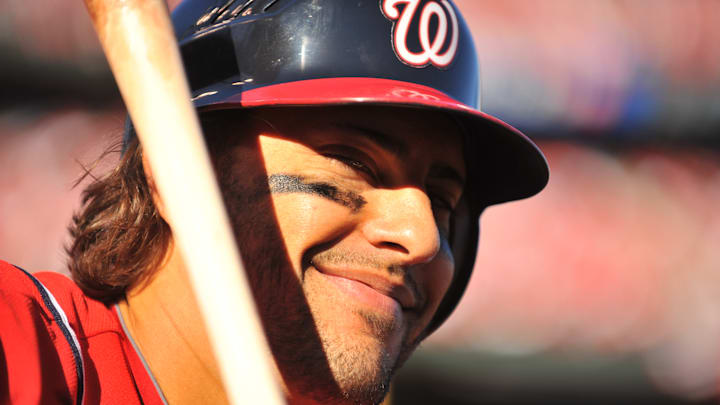Forgive me for always reflecting on the past, but it is extremely hard to stop writing about the past with how fun the 2012-2019 era of Nationals baseball was. There was nothing better than finishing school, going to baseball practice, having a homecooked meal (preferably gnocchi or a steak sub (or two)), then settling down to watch one of the best teams in baseball year after year. Clearly by my sequence of events homework was optional, and clearly, those days are behind us as I am currently worrying about Trevor Williams being the 5th starter.
Reflecting on my last article about Joey Meneses including his unbelievable run to end the 2022 season, it got me thinking about some of the biggest one hit wonders in Nationals history.
Victor Robles comes to mind, being a consensus top 5 prospect and putting up a solid season en route to a 2019 World Series victory, but he has still managed to hang around and provide some value after all these years. Adam LaRoche is another candidate with his incredible 2012 season with gold glove caliber defense with 33 home runs and 100 RBIs, but he remained solid through the 2014 season. After looking on the pitching side the first name that popped into my head was Joe Ross, but it is unfair to put him in this category based on his injury history, and still putting up solid numbers over his Nationals tenure.
That led me to a clear choice: Michael Morse and his 2011 season.
I have always been a huge Michael Morse guy. I started following the team daily in the late 2000s, and Morse was one of the first bright spots after a monster 2011 season came out of nowhere. At 6’5 and 250 pounds, Morse was an intimidating presence in the batter's box and hit some of the longest home runs in Nationals Park history. It is hard to believe he came up through the minors with the Mariners as a shortstop, with his shaky defense, at best, when we deployed him in left field and at first base.
After appearing in only 107 games from 2005-2008 with the Mariners hitting only 3 home runs, he was traded to Washington for outfielder Ryan Langerhans. Morse tore up the minors in 2009, getting called up later in the season and producing average numbers, before showing flashes and seemingly coming into his own in 2010.
After years of struggling with injury, and not having a full-time role or position, Michael Morse entered Spring Training in 2011 with a chip on his shoulder. After leading the Grape Fruit League with 9 home runs, Morse continued that success into the regular season.
Originally platooning with Laynce Nix in left field, Morse got his shot to play every day at first base when Adam LaRoche suffered a season-ending injury. In his first 4 games as the starting first baseman, Morse smashed 3 home runs with 8 RBIs, and from May 22 to July 5th, Morse hit 13 home runs with 35 RBIs, both ranking him first in the major leagues over that period.
Morse was a bright spot on a bad season, going from a platoon player who struggled to start the season after a good Spring Training, to receiving MVP votes for his monster 2011 season. Morse hit .303 with 31 home runs and 95 RBIs, putting him top 10 in the league in all three of those categories. His 148 wRC+ ranked him as the 13th-best hitter in all of baseball, just behind the American League MVP runner-up Jacoby Ellsbury and ahead of Albert Pujols in his last year in St. Louis before returning in 2022. Morse set a career-high in every single offensive category and registered 2.8 fWAR.
After an up-and-down 2012 season where Morse continued to be an above-average bat but a poor defender and struggled with injuries, he was shipped back to the Seattle Mariners in a three-team deal that netted us A.J. Cole, Blake Treinin, and Ian Krol from the Athletics.
After an up-and-down but solid career, Morse had an unfortunate ending in 2017, after former college football player and starting pitcher Jeff Samardzija close-lined him in an attempt to take down Bryce Harper during the infamous fight with Hunter Strickland. Morse suffered a concussion and never played again.
He finished his career with a memorable 2014 World Series Run with the San Fransisco Giants, a .274/.331/.457 slash line for 115 OPS+ and 105 home runs, and that 2011 MVP vote-getting season that I will never forget. He played 13 seasons with 2813 career plate appearances, amassing 4.6 fWAR. His 2011 war total ended up being over half of what he amassed the rest of his career. Morse will always be a "what could have been" if he could stay healthy and provide anything of value defensively. I’ll always remember him for his helmet-pounding celebrations after smacking long homers at Nats Park.
And never forget one of the best clips in Nationals history when Morse hit the phantom grand slam in 2012.
